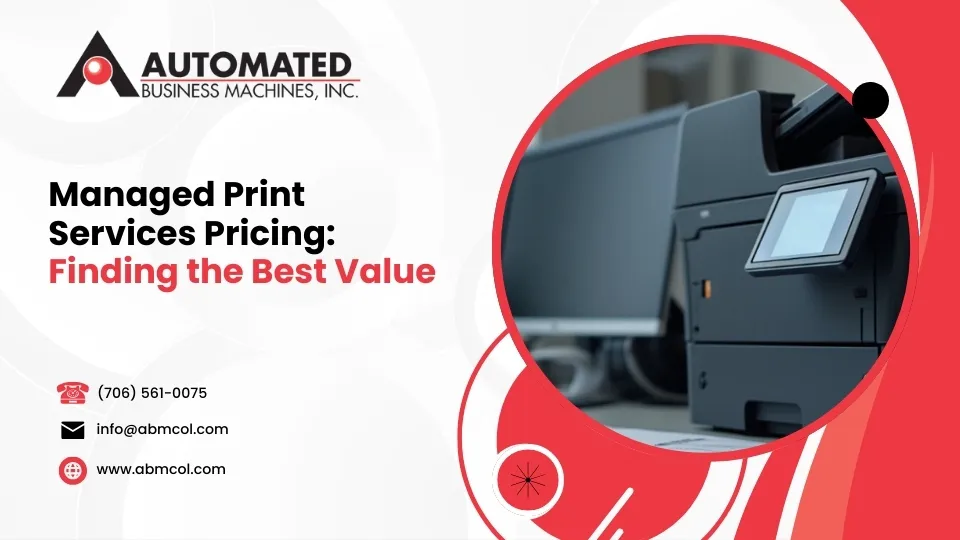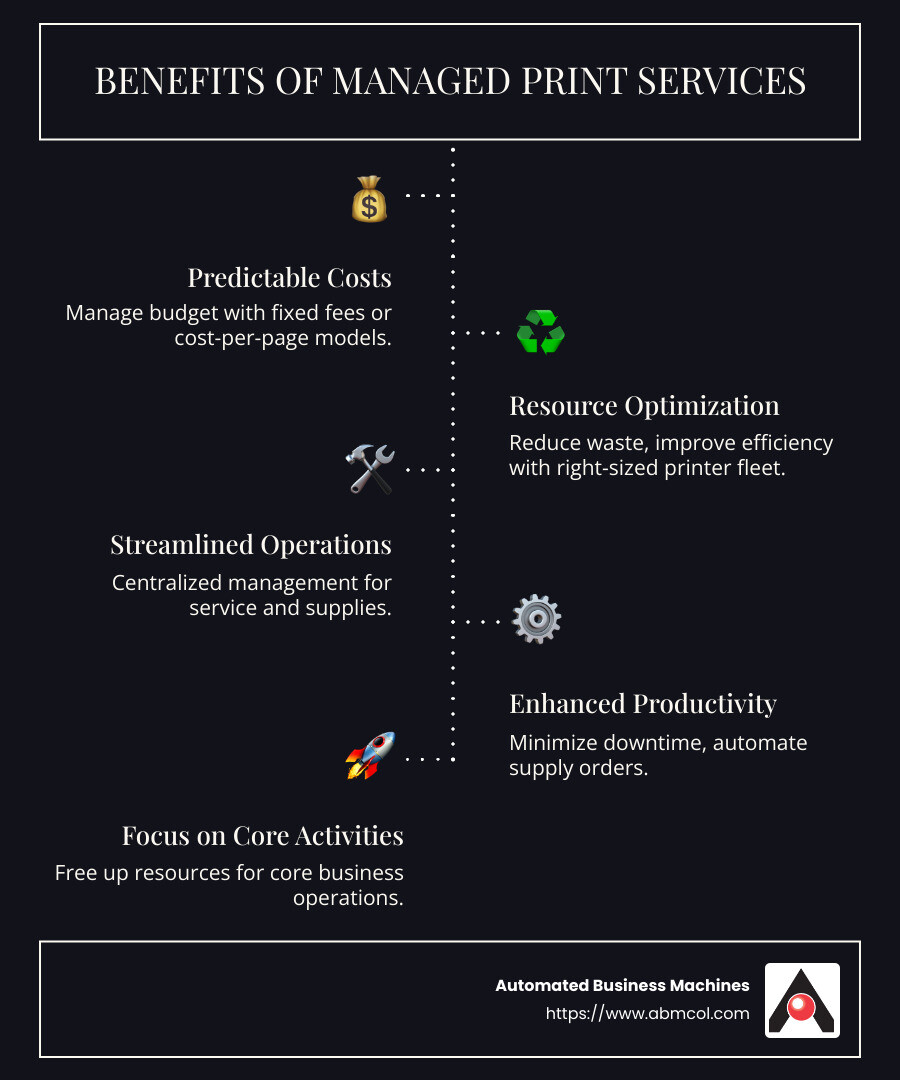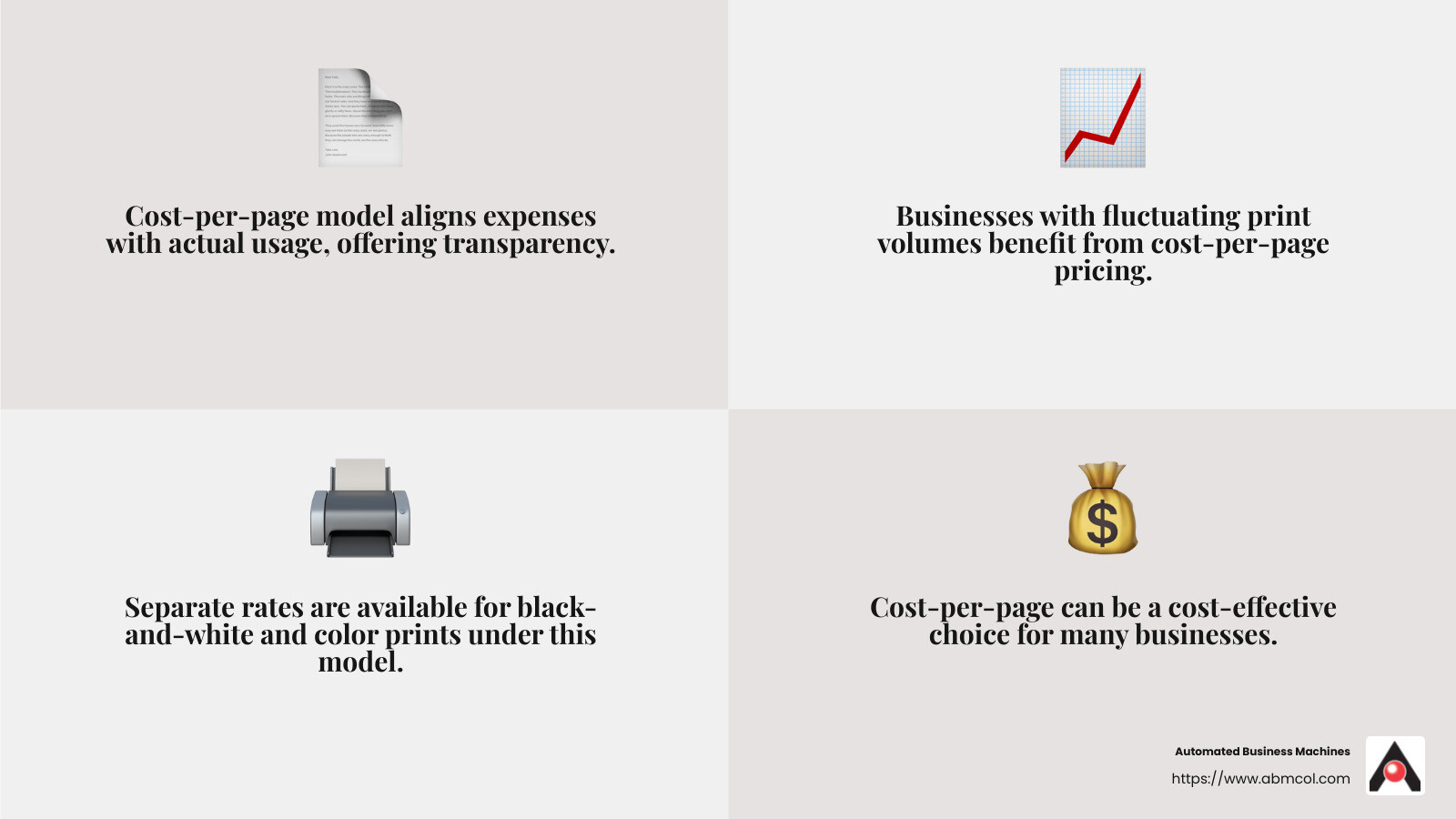
Managed print services pricing can often seem complex, but it holds the key to significant cost savings and improved efficiency in the office environment. For those seeking a quick insight on how these services can benefit your workplace, here’s a concise breakdown:
- Predictable Costs: Manage your budget with fixed fees or pay only for what you print with cost-per-page models.
- Resource Optimization: Reduce waste and improve efficiency with a right-sized printer fleet and proactive monitoring.
- Streamlined Operations: Enjoy centralized management of printing resources with one point of contact for service and supplies.
- Improved Productivity: Free up IT resources by minimizing downtime and automating supply orders.
Managed print services (MPS) have transformed traditional office printing, particularly for tech-savvy office managers juggling outdated equipment and high operating costs. These services not only streamline operations but also make print management more efficient and budget-friendly. With MPS, companies can focus on their core activities, leaving the print worries behind.
Consider the example of UW Health, which saved $300 per device on consumables and reduced their printer fleet by over 800 machines after adopting an MPS solution. Similarly, Velocity Urgent Care increased their locations without doubling their printer count, showcasing the power of strategic printer deployment.
The future of office management lies in integrated, secure, and cost-effective print solutions. MPS helps achieve that future by focusing on efficiency and cost savings, making it a valuable investment for businesses of all sizes.
Understanding Managed Print Services Pricing
When it comes to managed print services pricing, understanding the different pricing models can make a significant difference in how much you save and how efficiently you operate. Let’s break down the main components: cost per page, pricing models, and service coverage.
Cost Per Page
The cost-per-page (CPP) model is one of the most transparent ways to manage print expenses. Under this model, you pay a specific rate for each page printed, with separate rates for black-and-white and color prints. This approach ensures that your costs are directly aligned with your actual usage, making it a cost-effective choice for businesses with fluctuating print volumes.
Pricing Models
There are three primary pricing models in managed print services:
- Fixed Fees: This model involves paying a set amount each month, regardless of your print volume. It’s great for predictable budgeting but can be costly if your print usage is lower than expected.
- Cost Per Page: As mentioned, this model charges based on the actual number of pages printed. It’s ideal for businesses that experience varying print volumes throughout the year.
- Cost Per User: Here, costs are averaged out per user, making it easier to manage expenses. This model works well if your print usage is stable across your team.
Service Coverage
A crucial aspect of managed print services is the service coverage offered by your provider. This includes everything from routine maintenance and supply management to proactive monitoring and support. High-quality service coverage can reduce downtime and keep your operations running smoothly.
Choosing the right MPS provider means looking beyond just the price. It’s about finding a partner who offers comprehensive service coverage that aligns with your business needs. This ensures you get the best value for your investment, reducing waste and optimizing your print environment.
In the next section, we’ll explore the key factors that influence managed print services pricing and how understanding these can help you make informed decisions.
Key Factors Influencing Managed Print Services Pricing
When it comes to managed print services pricing, several key factors can significantly impact your overall costs. Understanding these elements can help you make the best choices for your business.
Print Volume
Your organization’s print volume is a crucial driver of MPS costs. The more you print, the lower your cost-per-page can be, as high volumes often lead to discounts. However, if your print volume is low, you might not benefit as much from volume-based pricing models. It’s essential to assess your typical print usage and choose a pricing model that aligns with it.
Device Efficiency
The efficiency of your printer fleet also plays a significant role in determining MPS pricing. Older devices tend to require more maintenance and repairs, which can increase costs. On the other hand, newer, more efficient models are usually cheaper to operate and maintain. It’s worth considering an upgrade if your current devices are outdated, as this can lead to long-term savings.
Service Level Agreements (SLAs)
The Service Level Agreement (SLA) you select is another critical factor. Basic SLAs might cover only essential maintenance and support, while more comprehensive agreements offer full maintenance, repairs, and supply management. A robust SLA can help you predict costs better and avoid unexpected expenses. Finding the right balance between service level and cost-effectiveness is vital.
Each of these factors—print volume, device efficiency, and SLAs—can significantly impact your managed print services pricing. By understanding and optimizing these areas, you can ensure you get the best value from your MPS provider. In the next section, we will dive into the various pricing models available and how they can fit different business needs.
Managed Print Services Pricing Models
When you’re looking at managed print services pricing, there are three main models to consider: fixed fees, cost-per-page, and cost-per-user. Each has its own advantages and can fit different business needs. Let’s explore them.
Fixed Fees
The fixed fees model is like a subscription. You pay a set amount each month, regardless of how much you print. This model is great for businesses that want predictable costs and don’t want to worry about fluctuating print volumes.
Pros:
- Predictable Costs: Easy to budget since the cost is the same every month.
- No Surprises: You won’t have unexpected charges if your print volume spikes.
Cons:
- Potential Overpayment: If you print less than expected, you might pay for pages you never use.
Cost-Per-Page
The cost-per-page model charges you based on the number of pages you print. This is ideal for businesses with varying print volumes, as you only pay for what you use.
Pros:
- Transparency: You know exactly what you’re paying for—each page printed.
- Cost-Effective: Aligns directly with your usage, so you don’t overpay during low-volume months.
Cons:
- Variable Costs: Monthly costs can vary, making budgeting a bit trickier.
Cost-Per-User
With the cost-per-user model, the price is based on the number of users who print, not the number of pages. This model can be beneficial for organizations where print volumes don’t change much but the number of users does.
Pros:
- Simple Billing: One flat rate per user, which can make accounting easier.
- Flexibility: Allows for easy adjustment if the number of users changes.
Cons:
- Potential Misalignment: If user print habits vary greatly, this model might not reflect actual usage.
Each of these pricing models offers unique benefits. Your choice should depend on your organization’s specific needs, such as print volume stability, the number of users, and budget flexibility. By selecting the right model, you can optimize your managed print services and achieve significant cost savings.
In the next section, we’ll dig into the benefits of managed print services and how they can improve your business operations.
Benefits of Managed Print Services
Managed Print Services (MPS) offer a range of benefits that can transform your business operations. Let’s explore the key advantages: cost reduction, productivity boost, and streamlined operations.
Cost Reduction
One of the most compelling benefits of Managed Print Services is the potential for significant cost savings. By optimizing your printer fleet and reducing waste, MPS can cut costs in several ways:
- Lower Consumable Expenses: With MPS, you can reduce spending on consumables like toner and paper. For example, UW Health saved an estimated $300 per device in consumables after adopting an MPS solution.
- Reduced Waste: MPS programs often include features like pull printing and automated duplex printing, which help decrease paper waste. UW Health also reported a 10–15% reduction in waste from abandoned print jobs.
- Fewer Devices Needed: By right-sizing your printer fleet, you can operate more efficiently with fewer devices. Velocity Urgent Care expanded to 16 locations but only added about a dozen printers, demonstrating how MPS enables you to do more with less.
Productivity Boost
Managed Print Services not only save money but also improve productivity across your organization:
- Proactive Maintenance: MPS providers offer remote monitoring and preventative maintenance, reducing downtime and keeping your devices running smoothly.
- Simplified Management: With one contact for service and supplies, your IT team spends less time managing printers and more time on strategic initiatives.
- Improved Security: MPS solutions often include improved security features, protecting your network from potential threats and ensuring compliance with regulations.
Streamlined Operations
Streamlining your printing operations can lead to more efficient workflows and better resource allocation:
- Centralized Control: MPS programs provide centralized control over your print environment, allowing you to monitor usage and optimize device placement.
- Just-in-Time Supplies: Automated supply ordering ensures you never run out of toner or other essentials, keeping your printers ready to go.
- Improved Reporting: With monthly reporting and print management software, you gain valuable insights into your print activities, helping you make informed decisions.
By leveraging these benefits, Managed Print Services can transform your printing environment, making it more efficient and cost-effective. In the next section, we’ll address some frequently asked questions about managed print services pricing.
Frequently Asked Questions about Managed Print Services Pricing
How is cost per print calculated?
The cost per print is determined by a combination of several factors:
- Cartridge Price: This is the cost of the toner or ink cartridges used in your printers. Original cartridges, like those from HP, are known for their reliability and quality, which can help avoid costly reprints.
- Page Yield: This refers to the number of pages a cartridge can print before it needs to be replaced. High-yield cartridges can lower your cost per print by providing more prints per cartridge.
- Paper Cost: The type and quality of paper used can also affect the overall cost per print. Using standard paper for everyday printing can help reduce costs.
By understanding these elements, you can better manage your printing expenses and optimize your printing environment.
What are the typical costs for black and white vs. color prints?
Printing costs can vary significantly between black-and-white and color prints:
- Black and White Prints: These are generally less expensive, with costs ranging from $0.003 to $0.05 per page, depending on your printer and usage.
- Color Prints: Color printing is typically more costly, with rates around $0.19 per page. This is due to the higher cost of color toner and the increased complexity of the printing process.
When planning your budget, consider your organization’s color printing needs, as they can significantly impact your overall printing costs.
How can managed print services reduce overall printing costs?
Managed Print Services (MPS) can lead to substantial cost savings in several ways:
- Reduced Wasted Supplies: By optimizing print settings and using features like pull printing, MPS minimizes waste from abandoned print jobs and unnecessary prints.
- Lower Maintenance Costs: With proactive maintenance and monitoring, MPS reduces the likelihood of printer breakdowns and extends the life of your devices, saving on repair costs.
- Decreased Downtime: MPS providers offer fast response times and remote troubleshooting, ensuring your printers are always operational, which boosts productivity and reduces downtime.
By addressing these areas, Managed Print Services can streamline your print operations and significantly reduce your overall printing costs. In the next section, we’ll explore how Automated Business Machines can tailor solutions to fit your specific needs.
Conclusion
At Automated Business Machines, we’re committed to transforming your print environment with customized solutions that enhance productivity and streamline operations. Our expertise in Managed Print Services (MPS) ensures that your organization benefits from significant cost savings and improved efficiency.
Our approach begins with a thorough assessment of your current print setup. We evaluate everything from device efficiency to print volume, ensuring our solutions are tailored to meet your specific needs. This personalized strategy allows us to optimize your print fleet, reduce waste, and minimize downtime.
Improved productivity is a key outcome of our services. By managing your print environment, we free up your IT team to focus on more critical tasks, while ensuring your printers are always up and running. Our proactive maintenance and fast response times mean less downtime and more time for your team to focus on what matters most.
Our locally owned and operated business spans multiple locations in Georgia, including Albany, Athens, and Atlanta, among others. This allows us to provide personalized service and support to our clients, ensuring that we’re always just a call away.
Choosing Automated Business Machines for your Managed Print Services means partnering with a team that values your success. We’re here to help you achieve cost-effective, efficient, and secure printing solutions tailored to your business needs.
Explore how our Managed Printer Solutions can make a difference for your organization today.



